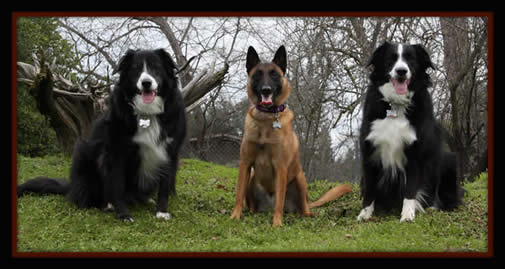



- ADVANCED CLASSES
- K9 NOSE WORK CLASSES
- CLICKER & FOR FUN CLASSES
- CAT CLICKER TRAINING
- FOR SALE - STORE


How To Choose A Dog Trainer

(based on the recommendations of the American Humane Association & Suzanne Hetts, PhD)
1). Get a referral from your veterinarian. Don't randomly sign up for just any training class.
2). Observe a class. Visit the class without bringing your pet. Are the dogs and people having fun? Talk to some of the participants after class. (If the trainer won't let you visit, don't enroll.) 3). Stick together. Avoid trainers who want to train your dog without you. You and your dog are both essential in developing a well-trained companion. During a session, don't allow a trainer to work with your dog unless he or she tells you exactly what is going to happen.
3). Look for treats. Avoid trainers who won't use food as a training reward. Food is a powerful positive training tool that works with most dogs. It also makes training fun.
4). Think positive. A trainer should use other positive rewards, such as play, for good behavior too. Clicker training is an approach that's gaining popularity; it involves pairing the sound of a hand clicker with something the dog loves. Soon, the sound itself become a remarkably effective reward for good behavior.
5). Avoid guarantees. They're a sign that a trainer doesn't understand the complexities of a dog's behavior and individual needs.
6). Shun harsh collars. Stay away from trainers who insist you use a choke chain or prong collar. There are now many humane alternatives such as head collars and halters. Shock collars should be avoided for routine training. If during training, you have any doubts about the way your pet is being treated, tell the trainer to stop.
![]()
![]()
![]()
![]()
![]()
![]()
![]()
![]()
![]()
For more info, you can also visit The Pet Professional Guild for help on methodology of Dog Training: https://petprofessionalguild.com/Top-Ten-Questions-To-Ask-a-Potential-Dog-Trainer/
&
Go to the APDT (Association or Pet Dog Trainers) Website: https://apdt.com/pet-owners/choosing-a-trainer/
&
 PPG The Ten Questions To Ask Your Dog Training Professional Before You Hire Them
PPG The Ten Questions To Ask Your Dog Training Professional Before You Hire Them
&
![]()
![]()
![]()
![]()
![]()
![]()
![]()
![]()
![]()
